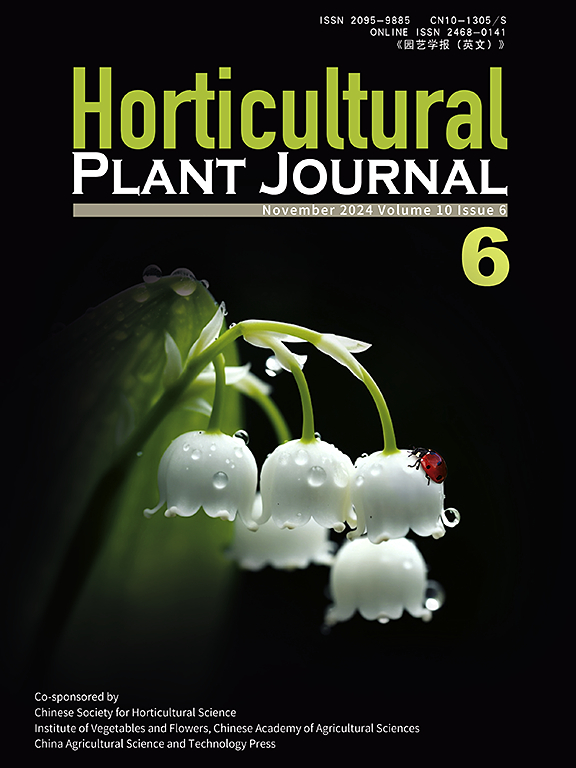大量分离分析、转录组和功能分析显示VcKCS19和VcCER2参与蓝莓果蜡积累的调控
IF 6.2
1区 农林科学
Q1 HORTICULTURE
引用次数: 0
摘要
蓝莓(Vaccinium L.)果实以其浅蓝色的外观而闻名,这要归功于它蓝黑色的皮肤上覆盖着一层白色的蜡质层。这一层对蓝莓果实的生长和储存至关重要。本研究建立了来自‘Chandler’(富含蜡质)和‘Black Pearl’(缺乏蜡质)的166株植物的F1图谱群体。利用Bulk segregated analysis sequencing对候选区域进行筛选,最终将候选区域缩小到11号染色体上1.85 Mb的片段,包含10个候选基因。进一步的转录组分析和qRT-PCR显示,“钱德勒”和“黑珍珠”的5个候选基因(VcMYB36、VcDXS、VcCAMS1、VcCER2和VcKCS19)的相对表达水平存在差异。结合基因功能注释,我们假设VcKCS19和VcCER2是蓝莓蜡合成的关键候选基因,可能解释了“钱德勒”和“黑珍珠”之间蜡含量的差异。VcCER2和VcKCS19在蓝莓果实中的瞬时过表达和病毒诱导的基因沉默表明,VcCER2和VcKCS19正调控蓝莓果实的蜡积累。该研究为蓝莓果实蜡合成的分子基础提供了重要的见解,为遗传育种中提高蜡质提供了新的途径。本文章由计算机程序翻译,如有差异,请以英文原文为准。
Bulk segregated analysis, transcriptome, and functional analyses reveal the involvement of VcKCS19 and VcCER2 in regulating blueberry fruit wax accumulation
The blueberry (Vaccinium L.) fruit is known for its light-blue appearance, attributed to its blue-black skin covered with a white waxy layer. This layer is crucial for the growth and storage of blueberry fruits. This study established an F1 mapping population of 166 plants derived from ‘Chandler’ (wax-rich) and ‘Black Pearl’ (wax-poor). Bulk segregated analysis sequencing was used to identify the candidate region associated with cuticular wax, which was finally narrowed to a 1.85 Mb segment on chromosome 11, including ten candidate genes. Further transcriptome analyses and qRT-PCR revealed that the relative expression levels of five candidate genes (VcMYB36 , VcDXS , VcCAMS1 , VcCER2, and VcKCS19 ) were different between ‘Chandler’ and ‘Black Pearl’. Combined with gene function annotation, we hypothesized that VcKCS19 and VcCER2 are key candidate genes for wax synthesis in blueberry, potentially accounting for the variations in wax content between ‘Chandler’ and ‘Black Pearl’. Transient overexpression and virus-induced gene silencing in blueberry fruit revealed that VcCER2 and VcKCS19 positively regulate wax accumulation in blueberry fruits. This study provided key insights into the molecular basis of wax synthesis in blueberry fruits, which provides new avenues for enhancing wax quality in genetic breeding programs.
求助全文
通过发布文献求助,成功后即可免费获取论文全文。
去求助
来源期刊

Horticultural Plant Journal
Environmental Science-Ecology
CiteScore
9.60
自引率
14.00%
发文量
293
审稿时长
33 weeks
期刊介绍:
Horticultural Plant Journal (HPJ) is an OPEN ACCESS international journal. HPJ publishes research related to all horticultural plants, including fruits, vegetables, ornamental plants, tea plants, and medicinal plants, etc. The journal covers all aspects of horticultural crop sciences, including germplasm resources, genetics and breeding, tillage and cultivation, physiology and biochemistry, ecology, genomics, biotechnology, plant protection, postharvest processing, etc. Article types include Original research papers, Reviews, and Short communications.
 求助内容:
求助内容: 应助结果提醒方式:
应助结果提醒方式:


